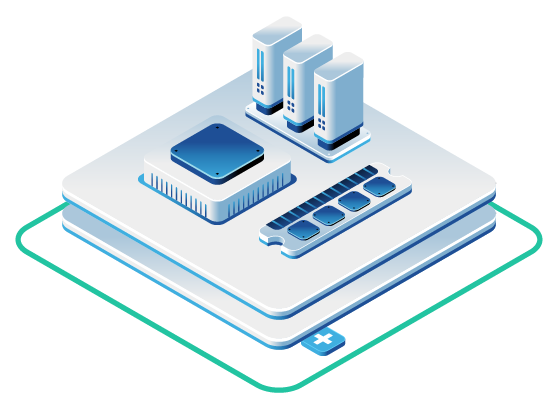Canonical vs OpenMetal
Deciding which OpenStack cloud solution makes the most sense for your business and use case? Let’s break down what each platform offers.
Compare OpenMetal and Canonical’s OpenStack-Powered Cloud Infrastructure Solutions
Selecting a cloud hosting solution can be a complex decision. There are many factors to consider like cost, performance, hardware specifications, and global reach.
This comparison guide will break down the offerings of OpenMetal vs Canonical to help you determine which provider is the best fit for your specific needs and budget. We’ll look at key features, pricing, and technical details to help you make an informed decision.
Jump To:
- Philosophies and Core Offerings
- Deployment Models and Control
- Core Technology and Hardware
- Management and Operations
- Pricing and Cost Structure
- Support and Services
- Scalability and Flexibility
- Security and Compliance
- Target Use Cases and Ideal Customer
- Comparison Table and Summary
- Which Solution Makes Sense For You?
OpenMetal and Canonical represent distinct approaches to cloud hosting, catering to different needs and priorities within the OpenStack Infrastructure-as-a-Service (IaaS) landscape.
 OpenMetal offers on-demand hosted private clouds built on dedicated bare metal infrastructure. Their core value lies in providing the isolation, control, and predictable performance of a private cloud with the rapid deployment speed typically associated with public cloud services. Customers get full root access to their OpenStack environment and underlying hardware, benefiting from transparent, hardware-based pricing and generous bandwidth, making it ideal for those seeking performance, control, and cost-efficiency without managing physical data centers.
OpenMetal offers on-demand hosted private clouds built on dedicated bare metal infrastructure. Their core value lies in providing the isolation, control, and predictable performance of a private cloud with the rapid deployment speed typically associated with public cloud services. Customers get full root access to their OpenStack environment and underlying hardware, benefiting from transparent, hardware-based pricing and generous bandwidth, making it ideal for those seeking performance, control, and cost-efficiency without managing physical data centers.
Canonical provides a versatile range of OpenStack solutions, empowering organizations to build and operate cloud infrastructure tailored to their specific needs and expertise. From fully managed OpenStack services that offload operational burdens, to powerful open source tools like MAAS (Metal as a Service) and Juju for building and automating self-managed private clouds, and MicroStack for small-scale or edge deployments, Canonical leverages Ubuntu’s robustness and security. Their offerings cater to diverse use cases, from large enterprises and telcos to developers and research institutions seeking customizable and scalable OpenStack environments with optional enterprise support.
With this guide, we hope to provide a neutral and comprehensive comparison of both providers’ cloud infrastructure capabilities to assist readers in making informed decisions based on their needs. We’ll cover aspects such as core offerings, support and management responsibilities, technology, pricing, and more.
OpenMetal
Focus: On-demand, hosted private clouds powered by OpenStack and Ceph built on dedicated bare metal.
Core Idea: Delivering the power, control, and predictable costs of a private cloud with the rapid deployment and ease of use often associated with public clouds. They emphasize transparency in pricing, full hardware access (root access), and no licensing fees due to their open source foundation.
Key Offering: “Cloud Cores” – starting with three or more hyper-converged dedicated servers running OpenStack and Ceph, deployed on-demand for a customer. They also offer dedicated bare metal, Ceph storage, and GPU servers and clusters.
Canonical
Focus: Providing flexible and efficient OpenStack solutions, from tools and support for do-it-yourself (DIY) private clouds to fully managed OpenStack services, all underpinned by Ubuntu.
Core Idea: Empowering organizations to build and operate OpenStack clouds with varying degrees of management and customization, using open source operational tools (like Juju and MAAS) for automation and lifecycle management.
Key Offerings:
- Managed OpenStack (formerly BootStack): Canonical designs, deploys, operates, and manages OpenStack on your hardware (on-premises or colocation) or in select partner data centers. This includes monitoring, patching, upgrades, and incident response for the OpenStack services.
- Charmed OpenStack (for Self-Managed): A collection of Juju “charms” (software operators) that automate the deployment, scaling, and management of OpenStack services. This allows organizations to build and operate their own OpenStack clouds with Canonical’s tooling and optional enterprise support.
- MicroStack (based on Sunbeam): A snap-based OpenStack distribution designed for small-scale, edge, development, and testing environments. It offers a simplified OpenStack experience, installable in minutes, and can be managed by Kubernetes operators. It can run on a single node or in a small multi-node cluster.
OpenMetal
Deployment: Hosted private cloud. OpenMetal provides and manages the dedicated bare metal servers on which your isolated OpenStack environment runs.
Control: Full administrative (root) access to your OpenStack control plane and the underlying bare metal servers (e.g., via IPMI/SSH). Customers control tenant structures, resource allocation, OpenStack project configurations, and the software running on their VMs. OpenMetal handles the hardware lifecycle and base OpenStack platform availability.
Canonical
Deployment:
- Managed OpenStack: Deployed on customer-selected hardware (on-premises or in a colocation facility) or in specified partner data centers. Canonical takes on the operational burden of the OpenStack layer.
- Charmed OpenStack (Self-Managed): Deployed on your chosen hardware in your data center. MAAS can be used for bare metal provisioning.
- MicroStack: Can be deployed on a single machine (laptop, server) or a small cluster of nodes, suitable for on-premises edge locations or development environments.
Control:
- Managed OpenStack: Customers control their virtualized workloads, applications, and OpenStack projects. Canonical manages the OpenStack infrastructure’s health, upgrades, and day-to-day operations according to the service agreement.
- Charmed OpenStack (Self-Managed): Full control over the hardware selection, OpenStack configuration, versioning, and ongoing operations. Canonical’s Juju and Charms automate many complex operational tasks, offering model-driven operations.
- MicroStack: Full control within its smaller, more constrained footprint; designed for ease of use and quick setup. Kubernetes operators handle its lifecycle management.
OpenMetal
OpenStack: Provides a production-ready version of OpenStack, deployed using tools like Kolla Ansible for containerized services. Ceph is the standard for hyper-converged storage (block, object, file), integrated into the Cloud Core.
Hardware: Offers a catalog of pre-configured, dedicated server options (e.g., varying CPU, RAM, NVMe/HDD storage ratios). These servers are owned and maintained by OpenMetal. Customers receive dedicated, non-oversubscribed resources, ensuring predictable performance. Multiple storage tiers, from local NVMe to distributed Ceph clusters with NVMe and HDD, are available.
Canonical
OpenStack: Supports recent stable releases of OpenStack. Charmed OpenStack uses Juju charms for deploying and managing each OpenStack service, often in LXD containers for isolation and optimized resource usage. It integrates with Ceph (via Charmed Ceph) for storage and supports various SDN solutions like OVN.
Hardware:
- Managed OpenStack: Canonical provides hardware recommendations and can work with a wide range of vendor hardware chosen by the customer or as part of the solution design.
- Charmed OpenStack (Self-Managed): Agnostic to specific hardware vendors. MAAS automates the discovery, commissioning, and deployment of operating systems (like Ubuntu) on a wide variety of physical servers, allowing customers to use their preferred hardware that meets OpenStack compatibility.
- MicroStack: Optimized for a minimal footprint and can run on devices with limited hardware resources, including a single server or even a developer’s workstation.
OpenMetal
Your Responsibility: Managing OpenStack projects, users, flavors, virtual machines, networks, security groups, volumes, and all aspects within your OpenStack tenant environment. You are also responsible for OS-level management and applications within your VMs.
OpenMetal’s Responsibility: Provisioning and maintaining the physical hardware, core network infrastructure, power, and cooling. They ensure the availability of the base OpenStack control plane provided as part of their service and offer a central management platform for hardware and cloud deployment. Assisted management is available as an option.
Canonical
Managed OpenStack:
- Your Responsibility: Workload deployment, application management, and OpenStack project/user administration.
- Canonical’s Responsibility: Full lifecycle management of the OpenStack infrastructure. This includes monitoring, patching, upgrades, scaling, security, and incident response for the OpenStack services themselves.
Charmed OpenStack (Self-Managed):
- Your Responsibility: Full operational responsibility for the hardware and the OpenStack cloud, including monitoring, patching, upgrades, and troubleshooting. Canonical’s tools (Juju, MAAS, Charms) are designed to heavily automate these tasks.
- Canonical’s Role (with support contract): Provides expert support, bug fixes, security updates for Ubuntu and OpenStack components, and guidance on best practices.
MicroStack:
- Your Responsibility: Managing workloads on MicroStack. Kubernetes operators handle the lifecycle management of MicroStack services.
- Canonical’s Role (with Ubuntu Pro subscription): Offers commercial support for OpenStack clouds deployed with MicroStack.
OpenMetal
Model: Primarily a fixed monthly recurring cost based on the dedicated hardware resources allocated to your private cloud. Hourly, monthly, and up to 5-year agreement terms are available, with discounts for longer commitments.
Transparency: Aims for highly predictable billing with publicly accessible pricing calculators. The cost is fixed for the chosen hardware configuration.
Bandwidth: Includes a substantial egress bandwidth allowance. Overages are billed using a 95th percentile method, which can be more cost-effective for bursty traffic than per-GB charges.
Licensing: No additional OpenStack software licensing fees due to being open source. Costs are for infrastructure and support.
Canonical
Managed OpenStack:
- Model: Typically a per-host, per-day, or per-month fee for the comprehensive management service. This is in addition to the customer’s costs for hardware and any data center/colocation fees.
- Transparency: Aims for transparent pricing for the management service suite.
Charmed OpenStack (Self-Managed):
- Model: The core tools (MAAS, Juju, Charmed OpenStack) are open source and free to use.
- Ubuntu Pro subscriptions provide security maintenance, kernel live patching, and optional support for the underlying Ubuntu OS on the OpenStack nodes.
- Optional OpenStack support contracts (via Ubuntu Advantage for infrastructure) are available at various tiers, priced based on factors like the number of nodes or overall cloud size.
MicroStack:
- Model: The MicroStack software itself is open source. Costs would be associated with the underlying hardware. Commercial support is available through an Ubuntu Pro subscription attached to the nodes.
OpenMetal
Support: Offers support focused on their platform – the hardware, the base OpenStack deployment, the OpenMetal portal/APIs, and Ceph storage. This includes onboarding assistance, complimentary consultations, assisted builds, and direct access to cloud engineers via shared Slack channels for collaborative support. Hardware management support is included.
Services: Primarily focused on the IaaS offering of a hosted private OpenStack cloud. They also maintain a community page listing OpenStack consulting and technical partners for additional assistance.
Canonical
Support:
- Managed OpenStack: Comprehensive, 24/7 operational support for the entire OpenStack infrastructure is an integral part of the service.
- Charmed OpenStack (Self-Managed): Tiered support options are available via Ubuntu Advantage for infrastructure, providing access to Canonical’s OpenStack experts for troubleshooting, bug fixes, security updates, and operational guidance. Extensive documentation and community support are also available.
- MicroStack: Commercial support is available with an Ubuntu Pro subscription.
Services:
- Consulting: OpenStack design, architecture, deployment, migration, and customization services with fixed-cost, outcome-guaranteed projects.
- Training: Offers official OpenStack training programs and courses on related technologies like Kubernetes and MLOps.
- Fully Managed Services: As detailed under Managed OpenStack.
OpenMetal
Scalability: Scale by adding more dedicated hardware nodes (servers) to your private cloud cluster. This is typically managed through the OpenMetal portal or API. The architecture is designed for both horizontal and vertical scalability of compute and storage resources.
Flexibility: High flexibility within your dedicated OpenStack environment. Full control over projects, networking (VLANs, VxLANs), and storage configurations using Ceph. Users have root access to the bare metal, allowing for significant customization. Customization of the underlying OpenStack services themselves is generally open, as users have full control.
Canonical
Scalability:
- Managed OpenStack: Scaling is planned and executed by Canonical as part of the service, typically involving adding more customer-approved hardware which Canonical then integrates into the managed environment.
- Charmed OpenStack (Self-Managed): Highly scalable. MAAS automates the provisioning of new bare metal nodes, and Juju with Charmed OpenStack allows for the dynamic scaling out (and in) of individual OpenStack services in a model-driven way. Designed for deployments from small to very large.
- MicroStack: Can scale from a single node to a multi-node cluster, providing resilience and increased capacity for smaller environments. High availability for the control plane and data plane is achievable with a minimum of three nodes.
Flexibility:
- Managed OpenStack: Flexibility in terms of workload deployment and supported OpenStack services is defined by the managed service agreement.
- Charmed OpenStack (Self-Managed): Extremely flexible. Customers choose their hardware and network topology and can integrate a wide array of OpenStack projects and third-party plugins. Full control over all OpenStack configurations.
- MicroStack: Offers sensible defaults for core OpenStack services (compute, network, storage) for a simpler experience, making it less complex but also less customizable than a full Charmed OpenStack deployment.
OpenMetal
Security:
- Dedicated hardware provides inherent physical tenant isolation.
Customers have full control over OpenStack security groups, network ACLs, and all VM-level security measures. - OpenMetal manages the security of their underlying infrastructure.
- Data centers have 24×7 on-site security, support compliance with various federal regulations and industry standards, and hold certifications including SOC 1 and 2, PCI, ISO, and HIPAA.
- Offers features like DDoS protection. Customizable security policies and built-in OpenStack monitoring tools are available.
Compliance: The single-tenant, dedicated nature of the hardware can help organizations meet various compliance requirements (e.g., HIPAA, PCI-DSS). Customers are responsible for the compliance of their workloads and applications within their private cloud environment. OpenMetal provides a foundation that supports compliance efforts, including features for role-based access control.
Canonical
Security:
- Leverages Ubuntu’s extensive security features, including AppArmor for mandatory access control, seccomp, secure boot, full-disk encryption, and access to kernel live patching and extended security maintenance (ESM) via Ubuntu Pro.
- Charmed OpenStack allows for isolated services in containers.
Supports Keystone for identity management and integration with existing authentication systems. Provides tools and guidance for secure OpenStack architecture. - For Managed OpenStack, Canonical implements and maintains security best practices for the underlying infrastructure.
- Offers Intel TDX-optimized Ubuntu images for confidential computing in private clouds, enhancing data protection with hardware-rooted primitives.
Compliance: Canonical provides a secure foundation (OS and OpenStack components) and operational practices that can help customers meet various compliance standards (e.g., HIPAA, PCI-DSS, GDPR). Ubuntu has FIPS 140-2 certified modules. Customers remain responsible for their specific workload, data, and application-level compliance. Managed services can include assistance with infrastructure-layer compliance controls.
OpenMetal
Organizations requiring the isolation, performance, and control of a private cloud without the complexities of managing physical data centers or undertaking lengthy OpenStack deployments from scratch.
Users needing predictable, transparent, and often lower cloud costs, especially for stable, scaled workloads.
Businesses with high bandwidth consumption looking to minimize egress fees.
MSPs, SaaS providers, software developers, AI/ML workload operators, blockchain companies, research institutions, and companies with performance-sensitive applications, specific data sovereignty concerns, or strict security/isolation requirements.
Teams comfortable managing an OpenStack environment (or willing to learn) but prefer to offload hardware management and initial setup.
Canonical
Managed OpenStack: Enterprises that want the benefits of a dedicated OpenStack private cloud but prefer to outsource all infrastructure operations, management, and maintenance to focus entirely on their applications and services. Organizations with existing hardware investments or specific colocation needs.
Charmed OpenStack (Self-Managed): Organizations with in-house technical expertise (or aiming to build it) that want full control over their private cloud environment, from hardware to software. Suitable for those who value automation, model-driven operations (via Juju), and the flexibility to deeply customize their OpenStack deployment. Common in telcos (NFV/NFVI), finance, research, and large enterprises building scalable private or public IaaS.
MicroStack: Developers, testers, and educators needing a quick, simple OpenStack environment. Organizations deploying small-scale edge computing solutions or requiring a lightweight private cloud for specific applications or remote offices. CI/CD environments.
Comparison Table and Summary
The distinctions between OpenMetal and Canonical OpenStack at a glance.
| Feature | OpenMetal | Canonical Managed OpenStack | Canonical Charmed OpenStack (Self-Managed) | Canonical MicroStack |
|---|---|---|---|---|
| Primary Model | Hosted on-demand private cloud (OpenStack/Ceph) | Fully managed private cloud service | DIY private cloud with ops tools and support | Simplified OpenStack for small/edge |
| Hardware Ownership | Provided and managed by OpenMetal | Customer-owned/colocated | Customer-owned/chosen | Customer-owned |
| Hardware Types Available | Pre-configured catalog (compute, storage, GPU options) | Customer-chosen (Canonical advises) | Customer-chosen (wide compatibility via MAAS) | Customer-chosen (minimal reqs.) |
| OpenStack Management | Base by OpenMetal; tenant and VMs by customer | Fully by Canonical (infra and ops) | By customer, using Canonical tools (Juju, MAAS) | Simplified, K8s operators, by customer |
| Deployment Speed | Very fast (under one minute for pre-warmed hardware) | Weeks (design, deploy, validate) | Days to weeks (depending on complexity and scale) | Very fast (minutes) |
| Cost Structure | Fixed for hardware; 95th percentile bandwidth | Per-node management fee + hardware costs | Hardware costs + optional Ubuntu Pro and support | Hardware costs + optional Ubuntu Pro |
| Primary Storage Tech | Ceph (Hyper-converged by default) | Typically Ceph (Charmed Ceph), flexible | Typically Ceph (Charmed Ceph), highly flexible | LVM default; Ceph possible |
| Level of Control | High (full OpenStack and root bare metal access) | High (workloads), medium (infra – via Canonical) | Very high (hardware and full OpenStack config) | High (within its scope) |
| Networking Control | Full OpenStack (Neutron/OVN) control by tenant | Managed by Canonical; tenant config via OpenStack | Full control (Neutron/OVN, customer SDN choice) | Simplified Neutron (OVN) |
| Customization | High (within OpenStack on dedicated hardware) | Moderate (as per service agreement) | Very high (full OpenStack ecosystem access) | Lower (sensible defaults) |
| Automation Tooling | Internal (e.g., Kolla Ansible) + customer portal/API | Juju, MAAS, Charms (used by Canonical) | Juju, MAAS, Charms (for customer use) | Snap, Sunbeam (K8s operators) |
| Required Expertise | OpenStack user/admin; VM management | Application/workload focused | Deep OpenStack, Linux and infrastructure skills | Basic Linux and cloud concepts |
OpenMetal’s OpenStack-powered hosted private cloud may be a good choice when:
- You need rapid deployment of a dedicated, isolated OpenStack private cloud with predictable, hardware-centric costs.
- You want full root access to bare metal servers and your OpenStack environment but prefer not to manage the physical data center or hardware lifecycle.
- Your workloads have significant or bursty bandwidth needs, and you want to avoid high, unpredictable egress fees.
- You value an open source solution without vendor lock-in at the software layer.
- You want to mix and match an OpenStack private cloud with other hardware options like bare metal, GPU servers, and Ceph storage clusters.
Canonical Managed OpenStack may be a good choice when:
- You want a production-grade OpenStack private cloud but prefer to offload all day-to-day infrastructure operations, management, patching, and upgrades to a team of experts.
- You have existing hardware resources or specific colocation requirements and need a proven operator to run OpenStack on top.
- You require strong SLAs for OpenStack infrastructure uptime and operational support, managed by a third party.
Canonical Charmed OpenStack may be a good choice when:
- You have (or are building) the in-house expertise to operate a private cloud and desire maximum control, flexibility, and customization over your OpenStack environment.
- You want to leverage powerful, model-driven open-source tools (MAAS for bare metal, Juju for service orchestration) for robust automation and lifecycle management on your own hardware.
- You need the option of enterprise-grade support, security updates (via Ubuntu Pro), and expert consultation for your OpenStack deployment and the underlying Ubuntu operating system.
Canonical MicroStack may be a good choice when:
- You are a developer, tester, or running a small lab and need a quick and easy way to get a functional OpenStack environment up and running in minutes.
- You are exploring OpenStack functionality without the complexity of a large-scale deployment.
- You have edge computing use cases that require a lightweight, autonomous cloud infrastructure with a minimal footprint.
Ultimately, both OpenMetal and Canonical provide capable and trusted paths to harnessing the power of OpenStack for your business. We recommend working with sales and technical teams from either provider, discussing your specific use case, performance needs, operational capabilities, and budget to make the most informed decision for your IaaS strategy.
Interested in OpenMetal Cloud as a Canonical Alternative?
Schedule a Consultation
Get a deeper assessment and discuss your unique requirements.



































